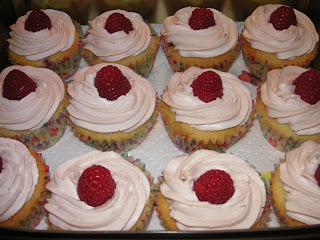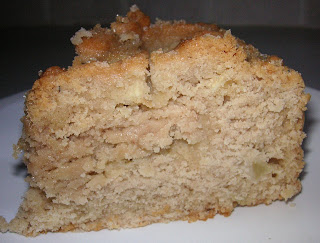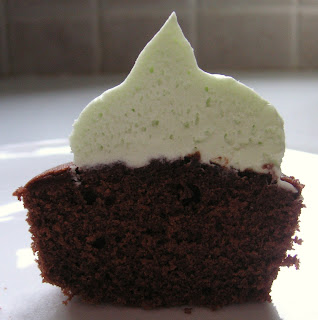
If you spend as many hours a day pondering cake as I do most thoughts are of the “I could really eat a slice of sponge right now” variety. Some however, are slightly more creative, take root and won’t allow themselves to be forgotten. This recipe is such an example.
I came across a recipe for old-fashioned coconut macaroons – the sort of macaroons that ruled the bakery/patisserie counter before the more glamorous upstart macarons came on the scene. Much as the photo made me drool, I knew I didn’t want to make just macaroons…but, as a cupcake decoration….that was a different story!
Coconut and raspberry is one of my favourite flavour combinations and I wanted the flavours represented in both the sponge and Swiss meringue buttercream. Being a coconutophile (I have invented a word) I boosted the flavour in my cupcakes by adding coconut extract, but it’s optional.
The delicate pink of the buttercream contrasts beautifully with the macaroon decorations. While the flavours can be enjoyed by everyone, I think the finished look is rather girly!
Here are the sponges before they were decorated:
I piped a flat layer of buttercream onto the cake and pushed the raspberry into it; this was to ensure that the buttercream filled the cavity of the raspberry. I could’ve stopped here as they looked stunning...:
...but I didn’t, as that’s not my nature! I piped more buttercream to enclose the raspberry:
The raspberry added good support for the macaroon topping!
Ingredients
For the coconut macaroons (this will make more than you need to decorate the cupcakes – if you only want enough for decorations with no spare consider halving the quantities):
100g caster sugar
2 egg whites
200g desiccated coconut
For the cupcake sponge (this will make 12 cupcakes):
125g unsalted butter, at room temperature
125g caster sugar
2 eggs
125g self raising flour
3 tablespoons desiccated coconut
1 teaspoon coconut extract
2 tablespoons milk
150g fresh raspberries (if you prefer, you could put some raspberry jam into the cupcake batter after you’ve spooned it into the paper cases)
Swiss meringue buttercream (enough for 12 cupcakes):
4 egg whites
250g caster sugar
250g unsalted butter, at room temperature
1 teaspoon coconut extract
1 heaped tablespoon raspberry jam (seedless)
Optional: 12 raspberries
Method
Start by making the coconut macaroons: preheat the oven to 180°C/fan oven 160°C/350°F/Gas mark 4.
Line two baking sheets with baking paper.
Whisk together the sugar and egg whites until fluffy; you don’t need peaks but just something that is starting to hold its shape and look a bit whippy.
Stir in the coconut until the mixture is well combined.
Spoon teaspoon sized amounts onto the baking sheet, leaving a small gap between them. You can use the teaspoon and a knife to shape them into little balls.
Bake for approximately 10 minutes or until the macaroons are just starting to brown, then remove from the oven and leave to cool on a wire rack (remove the macaroons from the tray when cool - if you try beforehand they might break).
To make the cupcakes, increase the oven to 190°C/fan oven 170°C/375°F/Gas mark 5.
Line a cupcake pan with paper cases.
Beat together the butter and sugar until light and fluffy.
Beat in the eggs, flour, desiccated coconut, coconut extract and milk.
Fold in the raspberries – some might break down but don’t worry.
When the mixture is smooth and well combined, spoon into the paper cases.
If you’re using raspberry jam instead of fresh raspberries, spoon a scant teaspoon into each cupcake and smooth a little batter over the surface so the jam won’t burn.
Bake for 12-15 minutes or until a skewer inserted into the cupcakes comes out clean. Mine took 13 minutes.
Leave to cool on a wire rack and remove from the tin when cool enough to handle. (You can make up to this point a day before serving – simply store the macaroons and cupcake sponges in an airtight container. Make the Swiss meringue buttercream on the day you wish to serve the cupcakes)
Now make the Swiss meringue buttercream: Place the egg whites and sugar in a bowl over a pan of simmering water. Stir pretty much constantly to prevent the egg from cooking.
After 5-10 minutes, when the sugar has dissolved (when you cannot see any crystals on the back of the spoon), remove the bowl from the pan of simmering water and whisk until the meringue has puffed up and is cool.
Add the butter and coconut extract to the meringue and whisk until the butter is completely incorporated into the meringue. At first it will look a disaster – it will collapse and look curdled but don’t worry – just keep going! Stop when the mixture is smooth, light and fluffy.
Beat in the jam.
Pipe the Swiss meringue buttercream over the cupcakes in glamorous swirls.
If using, push the raspberries into the buttercream and cover with more piped buttercream.
Set the macaroons gently into the buttercream so that they will hold their position.
Bask in the glory of the wonderful thing you have made.
Eat.
























































